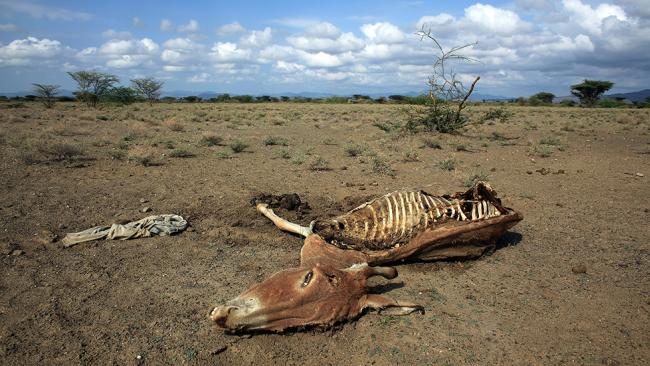By: By Michele Berger
Published: October 31,2013

Temperature plays a huge role in how quickly bodies decay. This
donkey succumbed to a drought in Kenya. (Christopher Furlong/Getty
Images)
“Temperature is the number one thing that influences the rate of decomposition,” affecting the bacteria and insects that aid in the process, Edward Mondor, associate professor of insect ecology at Georgia Southern University, told Weather.com.
“Weather plays a huge role,” added Daniel J. Wescott, director of the Forensic Anthropology Center at Texas State University. “If it’s too cold the insects won’t be active. If it’s too hot, it’ll kill off the insects.” Which insects specifically?
When an animal dies, blow flies are typically first to the scene, those metallic green, bug-eyed insects you likely see buzzing about on a warm, summer day. “The adults that are flying around, they are looking for the place to lay their eggs and that place is a dead body,” Mondor said. “That’s the only place their maggots can develop, in decomposing remains.” Sometimes flesh flies also arrive.
Beetles make their way to the carcass next, then scavengers like vultures and opossums.
All these creatures help whoever’s looking at the body to know how long it’s been there (just like you see on television shows like CSI and Bones). But there’s more to it. Whether it’s sunny, hot and humid, or shady, dry and cool matters. So does whether it’s cold and snowy.
Wescott does his work with human remains in central Texas, where temperatures can average in the 90s during the summer months. In the intense sun, the bodies “mummify pretty quickly, within about three months,” he said. “Then it takes a long time for them to decay past that. In shaded areas, after three to four months, they become a skeleton.” In general — though not always — he’s found that bodies decompose faster in hotter, more humid climes than in colder, drier spots.
This is true not only for human remains but animal remains as well, Wescott added.
Mondor’s work corroborates the theory. In Georgia, he studies what role shade has on an animal body’s decay. “It’s been said before we’re the Saudi Arabia of pine trees. We have more pine forests of any state in the United States,” he said. So he and colleagues opted to look at whether remains left in one of those forests changes faster than one left in the southern sun. So far they’ve found it to be true, guessing that the flies that assist with decomposition don’t like being scorched any more than we do.
Rain’s impact on decaying bodies is a little less straightforward than some other weather factors. Sometimes it washes the maggots away from the carcass, slowing the process. Sometimes it speeds it up, if the rain happens to liquefy the body. In the case of a human body that’s already been mummified, wet weather could potentially rehydrate the remains, speeding up what would’ve been an extremely slow decline, Wescott said.
Though we don’t know precisely how long it takes many specific animals to decay, we do have some numbers: A large whale could take up to 16 years to become skeletonized, according to a Nature paper about carrion. Small animals like a pig or a rat take a few days. Human remains, as Wescott mention above, take at least three months.
But again, it’s all about the weather, he added. “The regional weather makes a huge difference.”
No comments:
Post a Comment